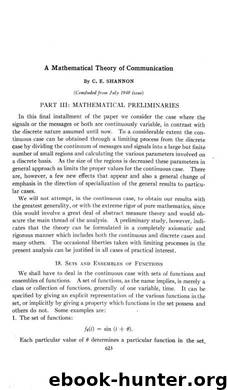BSTJ : A Mathematical Theory of Communication (Shannon, C.E.) by Unknown

Author:Unknown
Language: eng
Format: epub
Published: 1948-10-03T16:00:00+00:00
Tl
which requires A i, = - - C,/.
as
TT
In this case /I,-y = ^r ^<i ^^id both equations reduce to identities.
APPENDIX 7
The following will indicate a more general and more rigorous approach to the central definitions of communication theory. Consider a probability measure space whose elements are ordered pairs {x, y). The variables x, y are to be identified as the possible transmitted and received signals of some long duration T. Let us call the set of all points whose x belongs to a subset 5i of X points the strip over .^i, and similarly the set whose y belongs to ^2 the strip over 52. We divide x and y into a collection of non-overlapping measurable subsets Xi and Y; approximate to the rate of transmission R by
where
P(Xi) is the probability measure of the strip over Xi P(Yi) is the probability measure of the strip over I",-P{Xi, I.) is the probability measure of the intersection of the strips.
A further subdivision can never decrease Ri. For let Xi be divided into Xi = Xl + X[' and let
PiW) = a P(Xi) = b + c
P{X[) ^-b P{X[, ]\) - d
P{X") = c P{X'l, I",) - e
PiX,,\\) = d+e - ■■ -
Then in the sum we have replaced (for the A'l, I'l intersection)
((/ + e) log ———- by rf log — + e log — . a{o + c) ao ac
It is easily shown that with the limitation we have on b, c, d, e,
d + e
Download
This site does not store any files on its server. We only index and link to content provided by other sites. Please contact the content providers to delete copyright contents if any and email us, we'll remove relevant links or contents immediately.
Whiskies Galore by Ian Buxton(41880)
Introduction to Aircraft Design (Cambridge Aerospace Series) by John P. Fielding(33064)
Rewire Your Anxious Brain by Catherine M. Pittman(18553)
Craft Beer for the Homebrewer by Michael Agnew(18140)
Cat's cradle by Kurt Vonnegut(15184)
Sapiens: A Brief History of Humankind by Yuval Noah Harari(14252)
Leonardo da Vinci by Walter Isaacson(13182)
The Tidewater Tales by John Barth(12608)
Thinking, Fast and Slow by Kahneman Daniel(12074)
Underground: A Human History of the Worlds Beneath Our Feet by Will Hunt(12024)
The Radium Girls by Kate Moore(11921)
The Art of Thinking Clearly by Rolf Dobelli(10221)
A Journey Through Charms and Defence Against the Dark Arts (Harry Potter: A Journey Throughâ¦) by Pottermore Publishing(9232)
Mindhunter: Inside the FBI's Elite Serial Crime Unit by John E. Douglas & Mark Olshaker(9201)
Tools of Titans by Timothy Ferriss(8218)
Wonder by R. J. Palacio(8010)
Turbulence by E. J. Noyes(7936)
Change Your Questions, Change Your Life by Marilee Adams(7635)
Nudge - Improving Decisions about Health, Wealth, and Happiness by Thaler Sunstein(7615)
